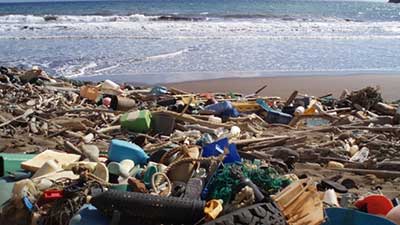Relevance: GS-3: Conservation, Environmental Pollution and Degradation, Environmental Impact Assessment.
Key Phrases: UN Ocean Conference, 30X30 by 2030, High Ambition Coalition for Nature and People, National Centre for Coastal Research (NCCR), Chennai, Beach Litter Survey, Single-use plastics, Plastic Waste Management Amendment Rules, 2021, Swachh Sagar, Surakshit Sagar campaign.
Why in News?
- At the high-level UN Ocean Conference in Lisbon, Portugal, India assured the world community that it is committed to protecting at least 30 percent of “our” lands, waters, and oceans, and thus adheres to its commitment of 30X30 by 2030 in a mission mode.
Background:
- India is part of the High Ambition Coalition for Nature and People, which was initiated at the “One Planet Summit” in Paris in January 2021, to promote an international agreement to protect at least 30 percent of the world’s land and ocean by 2030.
- India also offered to provide science and innovation-based solutions for the implementation of SDG-Goal 14 through partnerships and environmentally-friendly solutions at the World Ocean Summit.
SDG-Goal 14
- Goal 14 calls for the conservation and sustainable use of the oceans, seas, and marine resources.
- Its target 14.1 seeks to “prevent and significantly reduce marine pollution of all kinds, in particular from land-based activities, including marine debris and nutrient pollution” by 2025.
Marine and beach Litter:
- Single-use plastics contribute to over 50 per cent of marine litter, as per the pan-India coastal monitoring and beach clean-up activities are undertaken by the National Centre for Coastal Research (NCCR), Chennai, from 2018 to 2021.
- Beach Litter Survey:
- It has further revealed that the maximum litter accumulation occurs on the backshore than in the inter-tidal zone.
- The urban beaches have higher accumulation rates than rural beaches.
- Samples from coastal water, sediment, beach, and biota were analysed for micro/meso/macro plastics pollution.
- An increase in the abundance of microplastics was observed along India’s east coast during the monsoon.
- The stations closer to the river mouth in particular had higher numbers of microplastic concentrations.
- Several other studies have highlighted the harmful effects of litter, especially plastics, on marine biodiversity, ecosystems, fisheries, human health, and the economy.
- Usually, waste from land-based sources makes up the major share of marine litter.
Government Efforts:
- To phase out single-use plastic items by 2022, the Ministry of Environment, Forest, and Climate Change notified the Plastic Waste Management Amendment Rules, 2021.
- As per the Rules, India has banned the manufacture, import, stocking, distribution, sale, and use of identified single-use plastic items, which have low utility and high littering potential, across the country from July 1,2022.
- These domestic measures are part of international obligations as India, as a signatory of the UN “Coastal Clean Seas” campaign, has adopted and undertaken activities that have direct relevance to the “Swachh Bharat” vision to prevent pollution from both land-based and offshore activities, in line with Sustainable Development Goal 14.
Swachh Sagar, Surakshit Sagar campaign:
- India announced that it will undertake a massive coastal clean-up drive that will cover 75 beaches across the country – there will be 75 volunteers for every kilometre of the coastline.
- A 75-day-long awareness campaign, “Swachh Sagar, Surakshit Sagar” has been launched. It will culminate on International Coastal Clean-up Day on September 17.
- On September 17, the government, along with other voluntary organizations and local people will run the “Swachh Sagar, Surakshit Sagar” campaign along India’s entire coastline.
- It will be the first-of-its-kind and possibly the world’s longest-running coastal cleanup campaign with the greatest number of people participating in it.
- The participation of the common people will convey the message of “Swachh Sagar, Surakshit Sagar” for the prosperity of not only coastal areas but other parts of the country as well.
- A mobile app, “Eco Mitram”, has been launched to spread awareness about the campaign and facilitate the registration of volunteers.
- Efforts will be undertaken to collect scientific data and information on various matrices of marine litter.
- The target of the drive is to remove 1,500 tonnes of garbage from the coast, which will be a huge relief for marine life and the people staying in coastal areas.
Objectives of the Campaign:
- To run a cleanliness campaign along India’s entire coastline.
- Spread awareness about reducing marine litter.
- Minimize the use of plastics.
- Encourage segregation at source and waste management.
Who will participate?
- This campaign will include the Ministry of Earth Sciences (MoES), Ministry of Environment Forest and Climate Change (MoEFCC), National Service Scheme (NSS), Indian Coast Guard, National Disaster Management Authority (NDMA), Seema Jagran Manch, SFD, Akhil Bharatiya Vidyarthi Parishad (ABVP), Paryavaran Sanrakshan Gatividhi (PSG), along with other social organizations and educational institutions.
Conclusion:
- There is also a firm belief that through this campaign, a mass behavioural change among the masses will take place by raising awareness about how plastic usage is destroying our marine life.
Source: Indian Express
Mains Question:
Q. Swachh Sagar, Surakshit Sagar campaign to clean up the coasts and beaches speaks of India's seriousness towards restoring marine health. Discuss.







